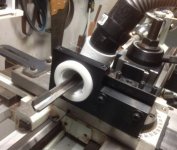With gun drilling , it is not super fast. You got the idea already and have air to blow out the chips/swarf. There are many ways to starting a hole with a gun drill. One is to pre drill or bore a pilot hole the same diameter as the gundrill about the length of the guide of the drill itself, generally 1.5 diameters of the hole. Another way is to use a drill guide bush. This is a very close sliding fit to the gun drill. It is correctly centred to the work piece. This will guide the gundrill for the initial start, and for any other passes that may be required.
When drilling , it does not have to be a perfect continuous feed all the way through. That would be ideal if it always chipped well and always cleared the swarf out. I have done both with the tailstock and the carriage holding the gundrill. I find the carriage one easier to manage , as it is on a Taig type lathe.
The alignment is the really important one. In my case, I made a block to hold the gun drill in my small Italian type tool post. I then made up a steel bar, that is the same length of my drill that fits the holder. This test bar has a centre in the back, for the tailstock centre to align the back. I hold the front of the test bar so it is just located into the collet by a few mm. On my setup, there is an adaptor plate that holds the QCTP to the cross slide. So any small miss alignment can be allowed for in the clearance of the screws. Once done up and set, and the cross slide locked into position or recorded in my case, can then take out the test bar, and put in the gun drill. The back end really does need to be within 2 thou of alignment other wise it can be the cause of a wondering hole. I find that just hand feeding is just fine, look at the chips coming out. I feed mine quite slow, in the 0.05mm to 0.1mm per rev range and I don't run mine very fast at all. I have my spindle at about the 400 rpm range, and feed the carriage or tailstock at a rate of about 20 to 30 mm per minute or so. The wood does not get hot, and the holes stay straight. If it the wood is getting hot, then it is either running too fast or the drill is getting dull. Getting dull is usually the main reason for the heat. They can be hand sharpened on a diamond wheel, but that is not for everyone. I set my pieces up and the collet steady and the collet chuck, but un supported out the very back of the spindle. I process and do the pilot hole ist on all the pieces, then reset up the gundrill to then drill the batch. That way I am not changing the setup. My main reason for going slow, is I found for me, that when going faster, the grain was influencing the cutting of the drill.
There is carbide double land/ double Margin drills, but at this stage are too pricey for me. These new to me double margin drills, have way faster drilling speeds and feeds and maintain a hole roundness similar to gun drills and will make as straight a hole . I use them at work and have borrowed the 16mm one for a test. It really is impressive.
Neil

![008 [800x600].jpg 008 [800x600].jpg](https://forums.azbilliards.com/data/attachments/378/378161-c89188ae601e29ee420a106b80e23eb4.jpg)
![007 [800x600].jpg 007 [800x600].jpg](https://forums.azbilliards.com/data/attachments/378/378162-3e003d3c2b04996ac462d2f21baa789c.jpg)